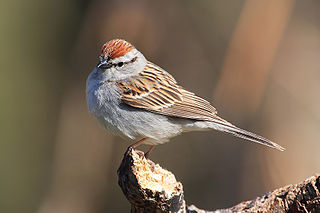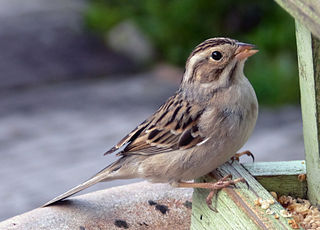
The American tree sparrow, also known as the winter sparrow, is a medium-sized New World sparrow.

The chipping sparrow is a species of New World sparrow, a passerine bird in the family Passerellidae. It is widespread, fairly tame, and common across most of its North American range.

The field sparrow is a small New World sparrow in the family Passerellidae. It is about 140 mm (6 in) long and weighs about 12.5 g (0.4 oz). The head is grey with a rust-coloured crown, white eye-ring and pink bill. The upper parts are brown streaked with black and buff, the breast is buff, the belly is white and the tail is forked. There are two different colour morphs, one being greyer and the other more rufous.

The clay-colored sparrow or clay-coloured sparrow is a small New World sparrow of North America.

The genus Spizella is a group of American sparrows in the family Passerellidae.

The cackling goose is a species of goose found in North America and East Asia.
Percy Algernon Taverner was a Canadian ornithologist and architect.

Brewer's sparrow is a small, slim species of American sparrow in the family Passerellidae. This bird was named after the ornithologist Thomas Mayo Brewer.

The black-chinned sparrow is a small bird in the genus Spizella, in the New World sparrow family Passerellidae. It is found in the southwestern United States and throughout much of Mexico north of the Isthmus of Tehuantepec; most populations in the US migrate south after breeding while those in Mexico are resident. It is a slim, long-tailed bird, primarily gray with a reddish-brown back streaked with black, brown wings and tail, a pink beak, and brownish legs and feet. In the breeding season, the male shows black on his throat, chin, and the front of his face. Females, youngsters and nonbreeding males show little or no black in these areas. An unobtrusive bird, it spends much of its time foraging slowly along the ground, either alone or in small groups, sometimes mixing with other Spizella species. It is an omnivore, feeding primarily on seeds during the winter and insects during the summer. It builds a cup-shaped nest of grasses, rootlets, or plant fibers, into which the female lays 2–5 pale blue eggs. The female does most or all of the egg incubation, but both parents feed the hatched nestlings.

The desert sparrow is a species of bird in the sparrow family Passeridae, found in the Sahara Desert of northern Africa. A similar bird, Zarudny's sparrow, is found in Central Asia and was historically recognised as a subspecies of the desert sparrow, but varies in a number of ways and is now recognised as a separate species by BirdLife International, the IOC World Bird List, and the Handbook of the Birds of the World Alive.

Swainson's sparrow is a species of bird in the sparrow family Passeridae. Sometimes considered a subspecies of the grey-headed sparrow, it occurs in northeastern Africa, largely in the Ethiopian Highlands. This sparrow was named after the English naturalist and illustrator William John Swainson.

The volcano junco is a New World sparrow endemic to the Talamancan montane forests of Costa Rica and western Panama.

Worthen's sparrow is a species of American sparrow that is endemic to northeastern Mexico. It was first described by Robert Ridgway in 1884 and named for the American naturalist Charles K. Worthen. This small bird has been listed as endangered by the IUCN since 1994.
The Daghestan pine vole is a species of rodent in the family Cricetidae. It is found in Russia, Georgia, Armenia, and Azerbaijan.
The dusky field rat, also known as the canefield rat, is a species of rodent in the family Muridae. It is found in Australia, Indonesia, and Papua New Guinea. In Australia it is found in northern Queensland and along the east coast as far south as Shoalwater Bay, where it is plentiful, and on South West Island in the Sir Edward Pellew Group off the Northern Territory, where it is considered a threatened species.
Chapin's crombec is an enigmatic African warbler, formerly placed in the family Sylviidae. It is currently considered a subspecies of the white-browed crombec, but might be a distinct species; too little is known about it to determine this now with reasonable certainty.

The yellow-throated greenbul is a species of the bulbul family of passerine birds. It is an African species found in east-central and southern Tanzania.

The Abd al-Kuri sparrow is a passerine bird endemic to the small island of Abd al Kuri in the Socotra archipelago of the Indian Ocean, off the Horn of Africa. Though this species was originally described as a distinct species, it was subsequently considered conspecific with the Socotra sparrow. A study by Guy Kirwan showed significant differences from the Socotra sparrow, and that the two sparrows might even have different origins. On the evidence that it is morphologically distinct, BirdLife International recognised it as a species, and it was listed in the IOC World Bird List from December 2009. It has a very restricted distribution, and a population of under 1,000 individuals, so despite not having any known threats it is considered a Vulnerable species on the IUCN Red List.













